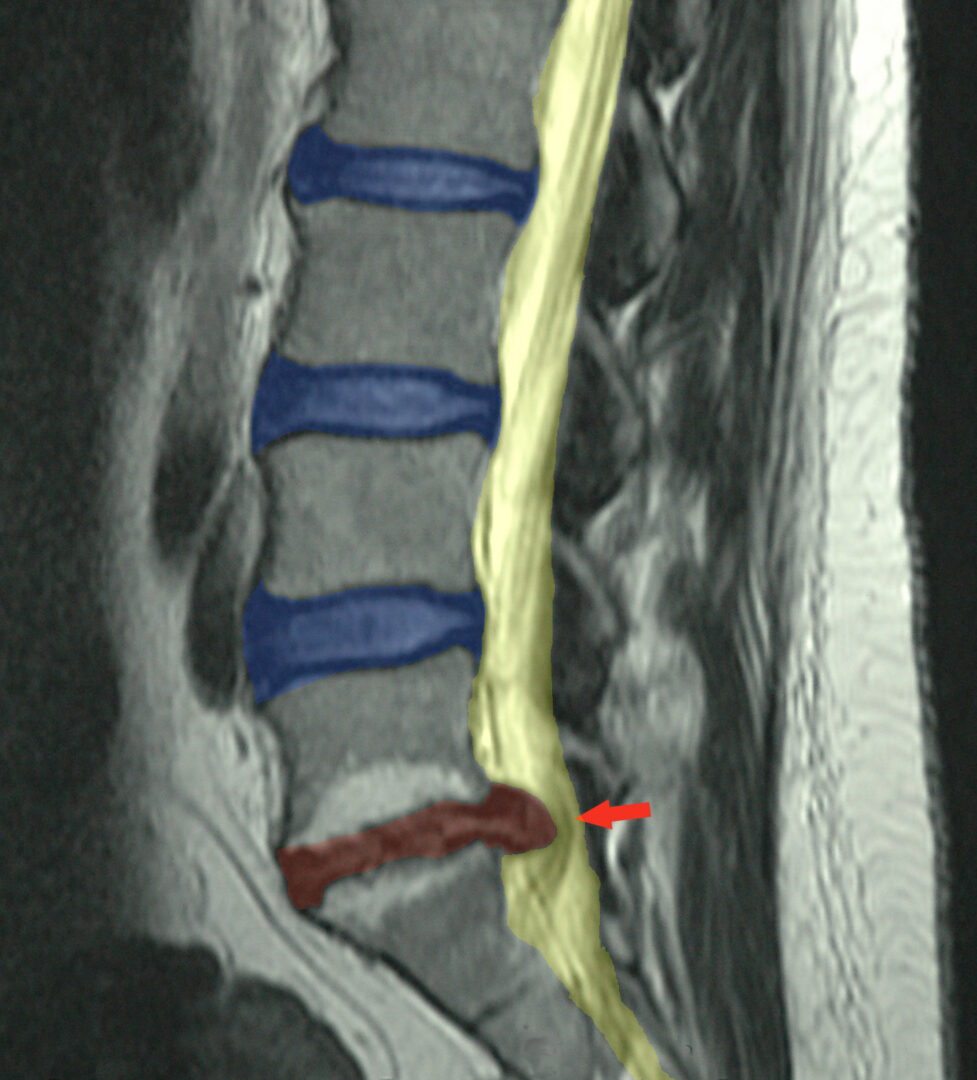About Lumbar Disc Herniation
Mark Nelson, M.D.
Specializing in Lumbar Disc Herniation
Mark Nelson, M.D.
Specializing in Lumbar Disc Herniation
Mark Nelson, M.D.
Specializing in Lumbar Disc Herniation
Lumbar Disc Herniation
Discs are flexible cartilage spacers located between the vertebral bones of the spine. They function like shock absorbers, and allow for normal spine movements.
Disc Herniation describes the breakdown or rupture of a disc beyond its normal boundaries. Disc herniation is also sometimes called disc protrusion, bulging disc, ruptured disc, slipped disc, herniated disc, or herniated nucleus pulposas.
Disc herniations can occur anywhere in the spine, but most commonly occur in the lower back called the lumbar spine. Therefore, a disc herniation in the low back is called a lumbar disc herniation, and a disc herniation in the neck is called a cervical disc herniation.

Explanation of Lumbar Disc Herniation on MRI
Blue discs are normal. The red disc is herniated. The spinal canal is shaded yellow. The gray lines within the yellow canal are the nerve roots. The red arrow points at the nerve root compressed by the herniated disc.
SYMPTOMS:
Symptoms of lumbar disc herniation include radiating pain, numbness and weakness.
Pain caused by lumbar disc herniations typically begins in the lower back and buttocks. It frequently radiates down the thigh, and sometimes continues into the leg and foot. These symptoms of radiating back, buttock, and thigh pain are commonly called sciatica, because they follow the course of the sciatic nerve.
Many patients also experience numbness or pins-and-needles type symptoms following a similar pattern.
Sometimes patients experience weakness in their thigh and leg muscles. Such weakness may manifest as a “drop foot”, loss of “push off” strength, or weakness with stairclimbing. Significant or progressive weakness is an indication for urgent consultation with a spine surgeon.
In rare circumstances, disc herniations can compress the nerves controlling bowel and bladder functions causing urinary retention or incontinence called a cauda equina syndrome. Fortunately, this is a very rare condition, but it is a surgical emergency for which a patient should proceed immediately to the nearest emergency room.
ANATOMY:
The lower back is called the lumbar spine. The lumbar spine is composed of five bones called vertebral bodies, or vertebrae. Between these bones are rubbery cartilage spacers called discs, or intervertebral discs. Each disc consists of an outer ring of tough fibrous tissue called the annulus fibrosis, and an inner rubbery portion called the nucleus pulposus. These intervertebral discs allow the spine to move, and function something like shock absorbers.
A disc herniation occurs when a disc breaks down, and a piece of disc material “herniates” or “protrudes” beyond its normal anatomic boundaries.
Nerve roots from the lower spinal cord run through the spinal canal right next to the discs and vertebral bones. Therefore, a herniated disc may compress or inflame the adjacent nerve roots causing symptoms of pain, numbness, and weakness following the course of the affected nerve.
TREATMENT OPTIONS:
Mark Nelson, MD recommends choosing treatment proportional to the severity, duration, and overall impact of the symptoms.
Basic conservative measures are generally recommended for short-lived and mild symptoms. Such conservative measures include: non-steroid anti-inflammatory medicines (like ibuprofen), avoiding inflaming physical activities, giving the body some time to heal itself, a home exercise and stretching program, and possibly physical therapy or chiropractic care.
Lumbar epidural steroid injections (also known as selective nerve root blocks) can be helpful in some cases of disc herniation that are unresponsive to basic conservative measures.
Surgery is appropriately considered in more serious cases, including severe pain, muscle weakness (i.e. drop foot), bowel or bladder changes, and in persistent cases that fail to respond to a reasonable course of conservative treatment.
The surgical removal of a herniated disc fragment is called a discectomy. This surgery can be performed through a very small incision with minimal disruption of adjacent tissues, and is frequently called a microscopic discectomy or microdiscectomy. Discectomy is very successful in relieving the severe radiating buttock, thigh, and leg pain caused by lumbar disc herniations.
Mark Nelson, MD is a board-certified, felllowship-trained orthopaedic spine surgeon who specializes in treating lumbar disc herniations and related spinal conditions. He provides a full spectrum of treatments including conservative care, epidural steroid injections, and surgical treatment when indicated.
A consultation with Dr. Nelson is an excellent way to learn more about your condition and best treatment options. Consultation with Dr. Nelson can be scheduled by calling his office at (858) 777-7917